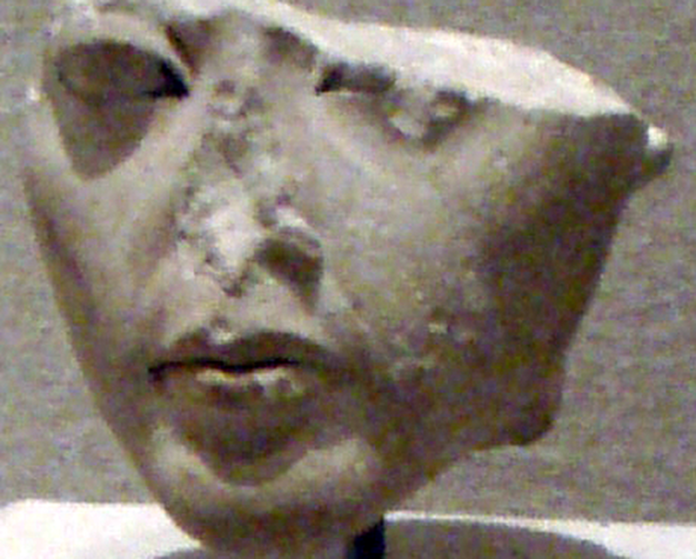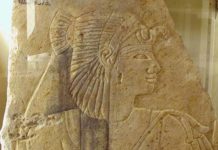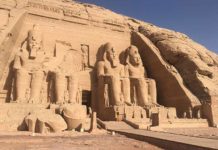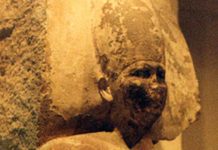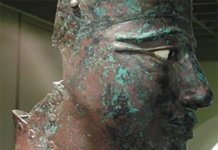If it wasn’t for the discovery of Tutankhamen’s all-but-intact tomb, this king of relatively small importance would have remained in obscurity. Had their tombs not long since been plundered, Tutankhamen would have paled against the great reigns of far more productive kings. But his legacy endures; fuelled not only by his intoxicating treasures but also the scent of mystery that intrigues even the most casual of amateur Egyptologists. Not the least of these mysteries concerns his wife, the Princess Ankhesenamun – at once depicted with her king in some of history’s most intimate artwork but ultimately shunned from his burial chamber and almost completely sweep from the pages of time.
Ankhesenamun – Early Life in the Royal Court
Ankhesenamun was born into a hugely influential chapter of royal history; she the third daughter of heretic pharaoh Akhenaton and his time-less wife, Nefertiti. Her name at birth, Ankhesenpaaten (She who lives through the Aten) reflects her father’s history changing monotheist reign. He would throw out generations of multiple god worship for that of his one true deity, the sun god Aten.
Although probably born in Thebes the princess, at an early age, moved to the newly established royal court in Amarna. This desert city represented the heart of Akhenaton’s religious and cultural revolution; ushering in an era of distinctive artistic flair that today defines the period. Many relief carvings of the time depict Ankhesenamun, along with her sisters and family, in decidedly unpretentious scenes never before depicted in Egyptian art.
There is much muddying of the royal lines of ascension but it is believed that, following the death of Nefertiti, Akhenaton married Ankhesenamun’s elder sister Meritaten. Subsequently, Meritaten is superseded and Ankhesenamun becomes her father’s wife and queen of all Egypt.
An elusive character, Smenkhare serves as co-regent during Akhenaton’s reign. Elusive in that his lineage is far from clear. Some have gone so far as suggest that he was, in fact, Nefertiti – yet it is more likely that he was Akhenaton’s son via his marriage to another of his wives, Kiya. Following Akhenaton’s death Smenkhare reigned as full pharaoh and married Ankhesenamun; who was very possibly his half-sister.
Marriage to Tutankhamen
Upon Smenkhare’s death, he too disappears from the records. Ankhesenamun marries yet again to her most famous of husbands; she is still only thirteen years old. Her husband and successor to the throne is eight, the boy king Tutankhamen. The royal couple would initially live in Amarna but then as religious traditions are again reinstated they move back to Thebes; changing their names in reflection of the Aten’s demotion.
- It is believed that the reign that followed lasted ten years and produced at least two still-born heirs; the tiny mummified remains of two girls were found within Tutankhamen’s excavated tomb.
- Tutankhamen’s administration was unexceptional but for its brevity; it was the events following his death that broke with tradition and left many unanswered questions.
- Tutankhamen dies suddenly at the age of eighteen; many long theorized murder but recent examination of his remains point to possible fatal infection following a leg fracture.
- His official advisor, Ay, rapidly ascends to power. He is perhaps Ankhesenamun’s grandfather and had long had influence over the affairs of Tutankhamen’s court.
- Tutankhamen’s burial is hastily arranged and seems to lack the tradition and respect that someone of his standing would usually be attributed.
- Ankhesenamun is noticeably absent from the tomb; tradition dictates that her personal belongings should be present but she is barely mentioned.
Ankhesenamun enters into what is the final of her incestuous relationships by marrying her grandfather, Ay and again becoming queen. This being the case, it is strange that no official monuments or references can be found in her name. One ring that describes her marriage to Ay has been discovered but this seems scant testimony to such a historically connected woman. Even the discovery of Ay’s tomb shed little light on her years following Tutankhamen’s death. Its walls are decorated with images of Tey, another of Ay’s wives but there is nothing of Ankhesenamun.
No further mention is made to her and no tomb has ever been discovered. If the theory is correct and she was married to four of the Amarna period’s prominent pharaohs then it would be assumed she deserved some elevated reverence; but instead she vanishes – completely and without trace.
The Hittite Letters
One possible reason that she has so completely been erased from history is treason. There is some evidence that following Tutankhamen’s death she tried to contact the Hittite King Suppiluliumas for assistance. The suggestion is that for reasons unknown Ankhesenamun felt alienated from her people and instead turned to their then enemy, the Hittites. A document was uncovered that dates to the approximate epoch of the Amarna period. Although unsigned, its author could tantalizingly bring some of the timelines strange events into cohesion.
‘My husband has died and I have no son. They say about you that you have many sons. You might give me one of your sons to become my husband. I would not wish to take one of my subjects as a husband… I am afraid.”
King Suppiluliumas duly verified the authenticity of the royal request and sent his youngest son, Zanannza to marry the Egyptian queen. Upon entering Egypt, the prince and his entire entourage were ambushed and murdered.
Was the ‘subject’ that the letters author referred to, Ay? Was she in fear that he had already began to seal power? Or perhaps the attribution of the letter to Ankhesenamun is merely wishful thinking by those trying to solve a puzzle that seems to have no combination.
Resources:
- El Mahdy, Christine; ‘Tutankhamen – The life and death of a Boy King’. (1999)
- Desroches-Noblecourt, Christiane; ‘Tutankhamen’. (1972)


